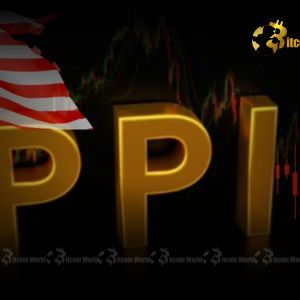US PPI Stunner: Unpacking the Unexpected Flat June Data and Its Impact on Cryptocurrency Market
7 min read
BitcoinWorld US PPI Stunner: Unpacking the Unexpected Flat June Data and Its Impact on Cryptocurrency Market In a truly surprising turn of events that has sent ripples across global financial markets, the latest US PPI (Producer Price Index) report for June has defied widespread market expectations , registering an unexpected flatness. This critical piece of inflation data could signal a significant shift in the economic landscape, potentially influencing the future stance of the Federal Reserve and, by extension, the volatile yet captivating cryptocurrency market . For investors and enthusiasts alike, understanding the nuances of this report is paramount to navigating the evolving economic tides. What Did the Latest US PPI Report Reveal? On a day when analysts were bracing for a slight increase, the U.S. Department of Labor delivered news that caught many off guard. According to data from the U.S. Bureau of Labor Statistics, as shared by Investing.com, the Producer Price Index (PPI) remained unchanged in June from the previous month. This flat reading sharply contrasts with the consensus market expectations of a 0.2% increase, suggesting that inflationary pressures at the producer level might be cooling more rapidly than anticipated. Delving deeper into the numbers, the year-over-year PPI also painted a picture of moderating inflation. It rose by 2.3% on an annual basis, falling below the forecast of 2.5% and notably declining from the 2.7% recorded in May. This deceleration in producer prices is a welcome sign for policymakers battling persistent inflation, as it often foreshadows a similar trend in consumer prices. Here’s a quick snapshot of the key figures: Monthly PPI (June): 0.0% (vs. 0.2% expected) Annual PPI (June): 2.3% (vs. 2.5% expected, 2.7% in May) This data point is not just a statistical anomaly; it’s a crucial indicator that can influence everything from corporate earnings to the purchasing power of the average consumer. Its immediate impact on bond yields and equity markets was palpable, and its delayed effect on the Consumer Price Index (CPI) makes it a closely watched figure for economists and investors. Why is This Inflation Data So Important? Understanding PPI’s Role To fully grasp the significance of the flat US PPI , it’s essential to understand what the index represents and its relationship with broader economic indicators. The Producer Price Index measures the average change over time in the selling prices received by domestic producers for their output. In simpler terms, it tracks the prices that businesses receive for the goods and services they produce. Think of it as a leading indicator for consumer inflation. When producers face higher costs for raw materials, labor, or transportation, they often pass those costs on to consumers in the form of higher prices. Conversely, if producer prices remain flat or decline, it suggests that the cost burden on businesses is easing, which can eventually translate to stable or even lower prices for consumers. The PPI is intricately linked to the Consumer Price Index (CPI), which measures the average change over time in the prices paid by urban consumers for a market basket of consumer goods and services. The relationship is often described as a pipeline: changes in PPI tend to be reflected in CPI with a lag. Therefore, a flat PPI reading offers a glimmer of hope that the persistent consumer inflation, which has plagued economies worldwide, might finally be losing its grip. How Does This Impact the Federal Reserve ‘s Strategy? The Federal Reserve , the central bank of the United States, has a dual mandate: to achieve maximum employment and maintain price stability. For the past year, their primary focus has been taming rampant inflation through aggressive interest rate hikes. Higher interest rates make borrowing more expensive, which slows down economic activity and, in theory, reduces demand, thereby bringing down prices. The flat June US PPI report introduces a fascinating dilemma for the Fed. On one hand, it provides evidence that their monetary tightening policies might be working, giving them reason to consider pausing or slowing down the pace of future rate hikes. A less aggressive Fed could mean a softer landing for the economy, avoiding a deep recession while still bringing inflation under control. On the other hand, the Fed remains cautious. They have repeatedly stated their commitment to bringing inflation down to their 2% target. While PPI is a positive sign, they will also be closely scrutinizing other indicators, particularly the upcoming CPI report and employment data, before making definitive decisions. The challenge for the Federal Reserve is to strike a delicate balance: tighten enough to quell inflation without stifling economic growth entirely. Did Market Expectations Miss the Mark? Unpacking the Discrepancy The fact that the US PPI came in flat, defying the consensus forecast of a 0.2% increase, highlights a significant disconnect between market expectations and economic reality. Why did analysts anticipate a rise, and what does this miss imply? Typically, market forecasts are based on a myriad of factors, including previous economic data, global supply chain conditions, energy prices, and geopolitical events. Many economists likely factored in the lingering effects of past inflation, potential supply disruptions, and perhaps a more resilient demand environment. The flat reading, however, suggests that disinflationary forces are stronger than previously modeled or that businesses are absorbing costs rather than passing them on. This discrepancy between expectation and reality can trigger significant market reactions. When a key economic indicator deviates sharply from forecasts, it forces investors to re-evaluate their positions and adjust their strategies. For instance, a flat PPI might be interpreted as a sign that the economy is indeed slowing down, which could lead to a reassessment of corporate earnings outlooks and investment flows. What Does This Mean for the Cryptocurrency Market ? The relationship between traditional economic indicators and the cryptocurrency market has become increasingly pronounced. As digital assets mature and attract institutional investment, they are more susceptible to macro-economic forces, particularly those driven by central bank policy and inflation. Here’s how the flat US PPI could influence the crypto landscape: Reduced Interest Rate Pressure: If the flat PPI signals a cooling of inflation, it lessens the pressure on the Federal Reserve to continue aggressive interest rate hikes. Lower interest rates generally make traditional safe-haven assets (like bonds) less attractive and increase the appeal of riskier assets, including cryptocurrencies. This could provide a much-needed tailwind for Bitcoin, Ethereum, and other altcoins. Increased Investor Confidence: A perception that inflation is under control and that a severe recession might be avoided can boost overall investor confidence. This renewed optimism often translates into increased capital flows into speculative assets like crypto, as investors seek higher returns. Correlation with Traditional Markets: The crypto market often mirrors the sentiment in equity markets, particularly tech stocks. If the flat PPI leads to a rally in tech stocks due to reduced rate hike fears, crypto assets might follow suit, demonstrating their growing correlation with broader financial instruments. Volatility Remains: While the flat PPI is a positive signal, the cryptocurrency market remains inherently volatile. Geopolitical events, regulatory changes, and specific blockchain developments will continue to play significant roles in price action. Investors should remain vigilant and not solely rely on macro-economic indicators. For the crypto community, this data offers a cautious dose of optimism. It suggests that the macroeconomic headwinds that have suppressed crypto prices over the past year might be starting to abate. However, the path forward is rarely linear, and market participants should prepare for continued fluctuations. Actionable Insights: Navigating the New Economic Landscape For investors, both seasoned and novice, the flat US PPI report underscores the importance of staying informed and adaptable. Here are a few actionable insights: Monitor the Fed Closely: The upcoming CPI report and subsequent Federal Reserve meetings will be critical. Pay attention to statements from Fed officials for clues about their future policy decisions. Diversify Your Portfolio: While the news might be positive for risk assets, diversification remains key. Do not put all your eggs in one basket, whether it’s crypto or traditional investments. Understand the Macro Landscape: Recognize that crypto is no longer an isolated market. Its performance is increasingly tied to global macroeconomics. Educate yourself on indicators like PPI, CPI, and employment data. Practice Risk Management: Given the inherent volatility of the cryptocurrency market , always invest what you can afford to lose and set clear entry and exit strategies. Conclusion: A Glimmer of Hope for Risk Assets? The flat US PPI for June is undoubtedly a significant development, offering a powerful signal that inflationary pressures at the producer level are indeed subsiding. This unexpected moderation in inflation data provides the Federal Reserve with more flexibility, potentially paving the way for a less aggressive monetary policy and a softer economic landing. While the journey to complete price stability is far from over, this report offers a glimmer of hope for risk assets, including the dynamic cryptocurrency market , which often thrives in an environment of lower interest rates and increased liquidity. As we move forward, vigilance and informed decision-making will be paramount for all participants in this interconnected global economy. To learn more about the latest crypto market trends, explore our article on key developments shaping Bitcoin and Ethereum price action. This post US PPI Stunner: Unpacking the Unexpected Flat June Data and Its Impact on Cryptocurrency Market first appeared on BitcoinWorld and is written by Editorial Team

Source: Bitcoin World



